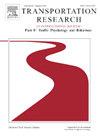The effect of ease of travel on travel behaviour and perceived accessibility: A focus on travel to university campus
IF 3.5
2区 工程技术
Q1 PSYCHOLOGY, APPLIED
Transportation Research Part F-Traffic Psychology and Behaviour
Pub Date : 2025-02-01
DOI:10.1016/j.trf.2025.01.035
引用次数: 0
Abstract
Ease of Travel (EoT), referring to people’s travel skills and motivations, and available travel options and quality can influence how people travel and how easily they can reach out-of-home activities. In this study, we explore the new concept of EoT and analyse its underlying structures using a sample of 2,593 students and staff members of University College London (UK). Subsequently, the determinants of EoT elements are examined, while we also analyse how EoT affects travel to campus and the perceived accessibility of the campus. Results suggest that EoT is effectively composed of the four elements motivation, skills, options and quality. These EoT elements are mainly affected by the residential location, travel disabilities, and the proximity of public transport and shared (e-)bikes. Finally, we found that EoT significantly impacts travel mode choice, travel distance and duration when travelling to campus, while positively affecting the perceived accessibility of the campus. Improving EoT levels, and making it easier for people to travel around, can result in shorter and more active trips and can also increase accessibility to out-of-home activities (improving people’s well-being). This could be realised by creating more compact, mixed-use neighbourhoods with easy access to public transport and shared (e-)bikes.
求助全文
约1分钟内获得全文
求助全文
来源期刊
CiteScore
7.60
自引率
14.60%
发文量
239
审稿时长
71 days
期刊介绍:
Transportation Research Part F: Traffic Psychology and Behaviour focuses on the behavioural and psychological aspects of traffic and transport. The aim of the journal is to enhance theory development, improve the quality of empirical studies and to stimulate the application of research findings in practice. TRF provides a focus and a means of communication for the considerable amount of research activities that are now being carried out in this field. The journal provides a forum for transportation researchers, psychologists, ergonomists, engineers and policy-makers with an interest in traffic and transport psychology.

 求助内容:
求助内容: 应助结果提醒方式:
应助结果提醒方式:


